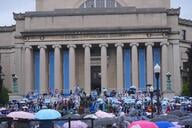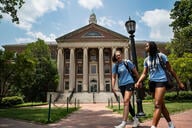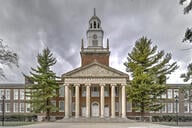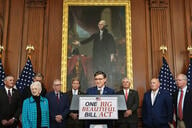You have /5 articles left.
Sign up for a free account or log in.
WASHINGTON — Just over 9 percent of students default on their federal student loans in the first two years after they begin paying them back, and 13.4 percent default in the first three years, according to data released Friday by the Education Department.
This is the first year the federal government has released the official default rate over three years, rather than two, which will later be used to determine colleges’ eligibility for federal financial aid. The two-year "cohort" default rate, which measures borrowers who entered repayment between October 2009 and September 2010, and defaulted on their loans by the end of September 2011 (during the 2010 fiscal year), continued a steady upward climb that began in 2005 and worsened with the recession. But the three-year rate, which this year measures borrowers who entered repayment between October 2008 and September 2009, and defaulted by the end of September 2011, dropped slightly. The two-year default rate for fiscal year 2009, released last year, was 8.8 percent.
The drop could indicate that a smaller proportion of students are defaulting, or that colleges, conscious that the three-year rates matter more this year than last, have been more proactive about pushing students who could not repay into deferment or forbearance, programs that allow students to postpone repayment without counting them as defaulters. The rising two-year rate, which is now at its highest level since 1996, was largely attributed to the still-struggling economy.
The rates varied significantly by sector. Students at public and nonprofit private colleges were much less likely to default than were students who took out loans to attend for-profit colleges. At public colleges, 11 percent of students defaulted on their loans in the first three years of repayment. At private nonprofit colleges, 7.5 percent defaulted over three years. At for-profit colleges, the three-year default rate was much higher: 22.7 percent.
Still, the two-year cohort default rate for for-profit college students dropped, from 15 percent last year to 12.9 percent this year. The three-year rate increased slightly, from 22.3 percent to 22.7 percent. (Note: This paragraph has been updated to correct the three-year cohort default rate for for-profit colleges.)
Critics of the sector say that more colleges have moved students who are not repaying their loans into forbearance, which staves off default but often doesn’t prevent it. In a statement, the president of the Association of Private-Sector Colleges and Universities, Steve Gunderson, said “we all must do more” to prevent loan defaults, calling on Congress to give colleges the ability to limit their students’ borrowing. “Student loan defaults are a serious problem for everyone – the nation, the higher education community, and especially the students,” Gunderson said.
Default rates also varied widely by the type of loan. Loans in repayment fall in the midst of a switch from the Federal Family Education Loan Program, in which the federal government lent money to banks and guaranty agencies to loan to students, to the Direct Loan program, in which the government lends to students directly. Some loans made by banks are now also serviced by the government, the result of the Education Department's purchasing those loans from the lenders at the height of the financial crisis in 2008.
Over all, FFEL loans had a much higher three-year default rate (14.6 percent) than did direct loans (8.6 percent). But the National Coalition of Higher Education Resources, a group representing guaranty agencies, lenders and servicers, said that FFEL loans purchased by the department amid the downturn had a much higher default rate than other FFEL loans. The group said the higher rate pointed to flaws in the departments’ servicing of those loans. According to NCHER’s analysis, 23.6 percent of federal loans purchased by the department were in default within three years, compared to 12 percent of federal loans overseen by the original lender or servicer. (The rate was still higher than the 8.6 percent three-year default rate for federal direct loans.)
The department has been plagued by problems with its loan servicing systems in the past year, including ongoing issues that make it difficult for borrowers to “rehabilitate” loans in default or to enter income-based repayment.
Two institutions lost eligibility for federal financial aid based on their two-year default rates: Centro de Estudios Multidisciplinarios, a nonprofit private college in San Juan, Puerto Rico, and Tidewater Tech in Norfolk, Va., a for-profit vocational college, both of which had default rates higher than 25 percent for three consecutive years. Sanctions based on the three-year rates will not begin until 2014, when three years of the three-year rates will have been published.
For now, colleges with three-year default rates of more than 30 percent must establish a default prevention task force and submit a plan to the Education Department. More than 200 colleges, the majority of which are for-profit colleges, will have to do so.




